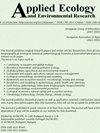沙特阿拉伯alqassim al-asyah地区rawdhat鲍木植被的物种多样性和区系组成
IF 0.6
4区 环境科学与生态学
Q4 ECOLOGY
引用次数: 0
摘要
本文章由计算机程序翻译,如有差异,请以英文原文为准。
SPECIES DIVERSITY AND FLORISTIC COMPOSITION OF RAWDHAT ABALWOROOD VEGETATION IN AL-ASYAH, ALQASSIM REGION, SAUDI ARABIA
. Rawdhat Abalworood in Al-Qassim region of Saudi Arabia is one of the most important rawdhats of this area. The present study provides insight of vegetation types, life forms, as well as floristic categories and species distribution, highlighting the ecological factors that influence species distribution. A total of 44 species representing 19 families of vascular plants were recorded. The dominating groups were Asteraceae and Brassicaceae, and the dominant life forms were therophytes and chamaephytes, displaying a typical desert life-form range. Two of the eighteen studied sites had the maximum species richness value of 15 species per plot. Five of the 18 sites studied had the lowest species richness assessing of 10 species per plot. The most frequent life form classes observed in Rawdhat Abalworood, Al-Asyah, Al-Qassim region were Therophytes (Th) and Chamaephytes (Ch), with 65.91% and 15.91%, respectively. Chorological analysis exhibited Saharo-Sindian (SA-SI) and Irano-Turanian-Saharo-Sindian (IR-TR+SA-SI) represented by 20.45% and 18.18, respectively. Chronologically, surveyed plant species were recognized into three categories; mono regional, bi regional, and pluri regional. The three chorological categories were represented by 31.81%, 50.0%, and 18.18%; respectively. Species diversity in terms of Margalef’s diversity index ( Figure 6A ) ranged between 1.6 to 2.6 with an average of 2.1 to 0.3, Shannon-Weiner diversity index ( Figure 6D ) showed close diversity levels as Margalef’s and ranged between 1.6 to 2.4 with an average of 2.1. Using CCA multivariate analysis effect of 6 environmental factors is distinguished upon vegetation. The CCA ordination revealed that the separation of Vegetation group III along the axis was influenced by Silt, WHC, OM, OC, and Clay, whereas VG II was substantially related to sand%.
求助全文
通过发布文献求助,成功后即可免费获取论文全文。
去求助
来源期刊

Applied Ecology and Environmental Research
ECOLOGY-ENVIRONMENTAL SCIENCES
CiteScore
1.40
自引率
14.30%
发文量
104
审稿时长
14 months
期刊介绍:
The Journal publishes original research papers and review articles. Researchers from all countries are invited to publish pure or applied ecological, environmental, biogeographical, zoological, botanical, paleontological, biometrical-biomathematical and quantitative ecological or multidisciplinary agricultural research of international interest on its pages.
The focus is on topics such as:
-Community, ecosystem and global ecology-
Biometrics, theoretical- and quantitative ecology-
Multidisciplinary agricultural and environmental research-
Sustainable and organic agriculture, natural resource management-
Ecological methodology, monitoring and modeling-
Biodiversity and ecosystem research, microbiology, botany and zoology-
Biostatistics and modeling in epidemiology, public health and veterinary-
Earth history, paleontology, extinctions, biogeography, biogeochemistry-
Conservation biology, environmental protection-
Ecological economics, natural capital and ecosystem services-
Climatology, meteorology, climate change, climate-ecology.
The Journal publishes theoretical papers as well as application-oriented contributions and practical case studies. There is no bias with regard to taxon or geographical area. Purely descriptive papers (like only taxonomic lists) will not be accepted for publication.
 求助内容:
求助内容: 应助结果提醒方式:
应助结果提醒方式:


